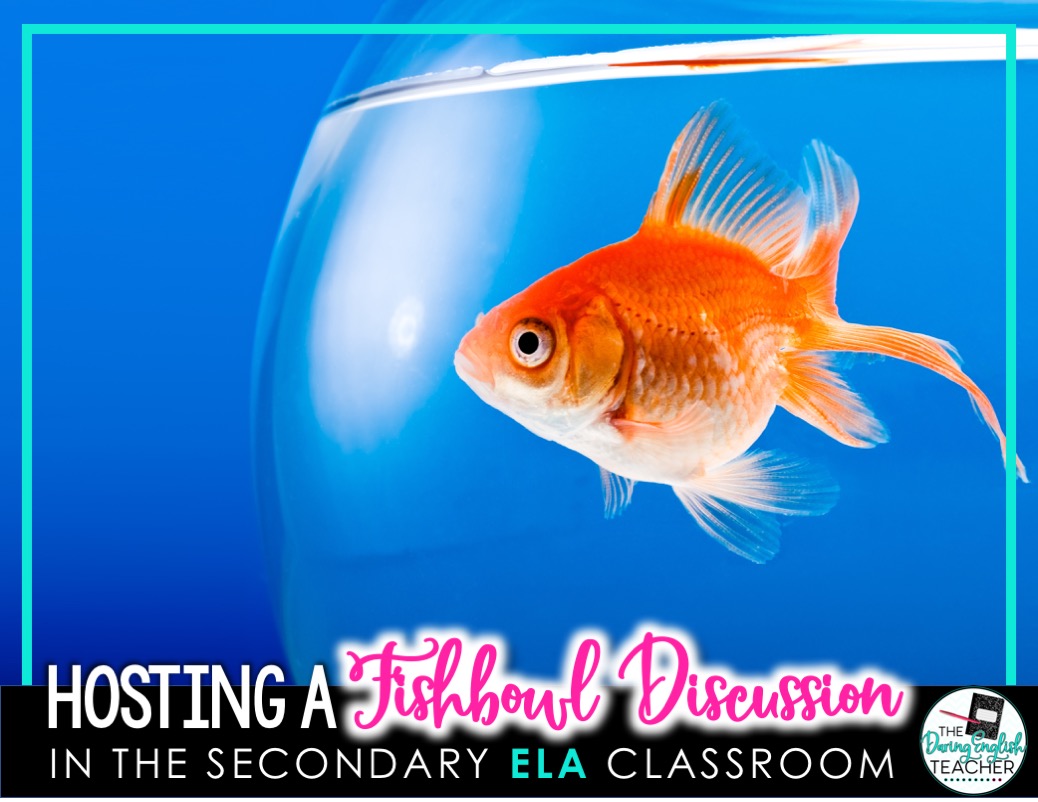If you’ve never conducted a fishbowl discussion in your classroom, you and your students are missing out. Similar to a Socratic Seminar, fishbowl discussions are organized classroom discussions that require students to prepare thoughtful responses to deliver in class.
I love using fishbowl discussions as an end of the unit review activity because I can give my students a lot of content to review and use to prepare for the discussion, and I can also use the discussion itself as a way to assess my students’ speaking and listening skills.
 Fishbowl Discussion Tip: Organize your Classroom
Fishbowl Discussion Tip: Organize your Classroom
You will want to prepare your classroom for the discussion. Typically, I place two tables or four desks in the center of the room. That is my fishbowl. During the discussion, four students will sit in the middle of the room and answer and discuss the topic questions. The rest of the tables and desks in the room are arranged in a circular pattern around the fishbowl.
That way, just like people look at the fish inside a fishbowl, the rest of the students in the classroom are looking at the students who are actively participating in the discussion. At the front of the room, or at the top of the fishbowl, I usually place two desks or one table. This is designated as the “hot seat.”
Fishbowl Discussion Tip: Prepare your students
In order for the fishbowl discussion to be effective, students need to be prepared for the discussion questions, and that is why this activity works very well as a review activity. Typically, a couple of days before the discussion, I will assign my students about 20-30 review questions to help them prepare for the discussion and the end-of-unit test.
Open-ended questions that require evidence and explanation and opinion-based questions typically work best for the discussion. When students can either agree with one another or disagree, the discussion will be more powerful.
The day before the discussion, I will have my students either work in groups to answer the questions, or I will conduct some sort of collaborative activity (gallery walk, question jigsaw, or review stations) that requires students to answer the questions.
Fishbowl Discussion: Conduct the Fishbowl Discussion
Before I begin the fishbowl discussion, I print out the review questions and cut them up into little strips. I then fold each strip a couple times and place them in some sort of bucket. I use my small bucket from the Target Dollar Spot.
I then explain the fishbowl procedures to my class: each student must speak at least once; each student must contribute something meaningful to the conversation that demonstrates their knowledge and understanding of the content; only the “fish” inside the fishbowl can answer the discussion questions and participate in the conversation; students sitting in the outside circle can participate at any time as long as they move to the designated “hot seat” location; only two students may occupy the “hot seat” location at a time; all students need to be respectful at all times; and once the fish inside the fishbowl are satisfied with their answers, they must tap in a student from the outside circle that hasn’t been inside the fishbowl yet.
I also explain to my students that they are being graded based on their responses and that in order to receive full credit, they must contribute something meaningful to the discussion.
Usually right before I begin this activity, I provide my students with some sentence starters and sentence frames to help them properly agree or disagree with their classmates. I want to model to them proper communication strategies that will help them in college and in the workforce.
Fishbowl Discussion Tip: Sentence Frames for the Fishbowl Discussion 
- “While I agree with ______ about ______, I also feel that_______.”
- “I respectfully disagree with _____ about his/her stance on ______ because I feel that ______.”
- “Adding onto ____’s contribution, I would also like to say ________.”
- “While _______ has a great point, I believe that _________.”
- “While I can see why _______ said _______, I think differently because _______.”
Holding a fishbowl conversation in your classroom is a great way to get all of the students involved in a classroom discussion. It is also a great way to help students learn difficult concepts and prepare for upcoming tests. Additionally, having fishbowl conversations in class helps students open up and share their thoughts because even though they are sharing their thoughts and answers with the entire class, the intimate setting of the four seats in the center feels more like an intimate conversation that a classroom presentation.
If you enjoy holding fishbowl discussions in your classroom, you may be interested in my Socratic Seminar resource. This resource will help prepare your students for Socratic Seminars and fishbowl conversations.



4 Comments
Thanks for the great reminder!
You are welcome.
This comment has been removed by the author.
Could you explain a little more about how this actually operates? How do you decide which students sit in the fishbowl, who sits in the hot seat, and who sits in the outer circle? Also, who asks the questions, you, or a student? I am also interested in knowing how much time you generally take for a discussion like this. Thank you for sharing your ideas and expertise.